ProgressiveRC 206B User Manual
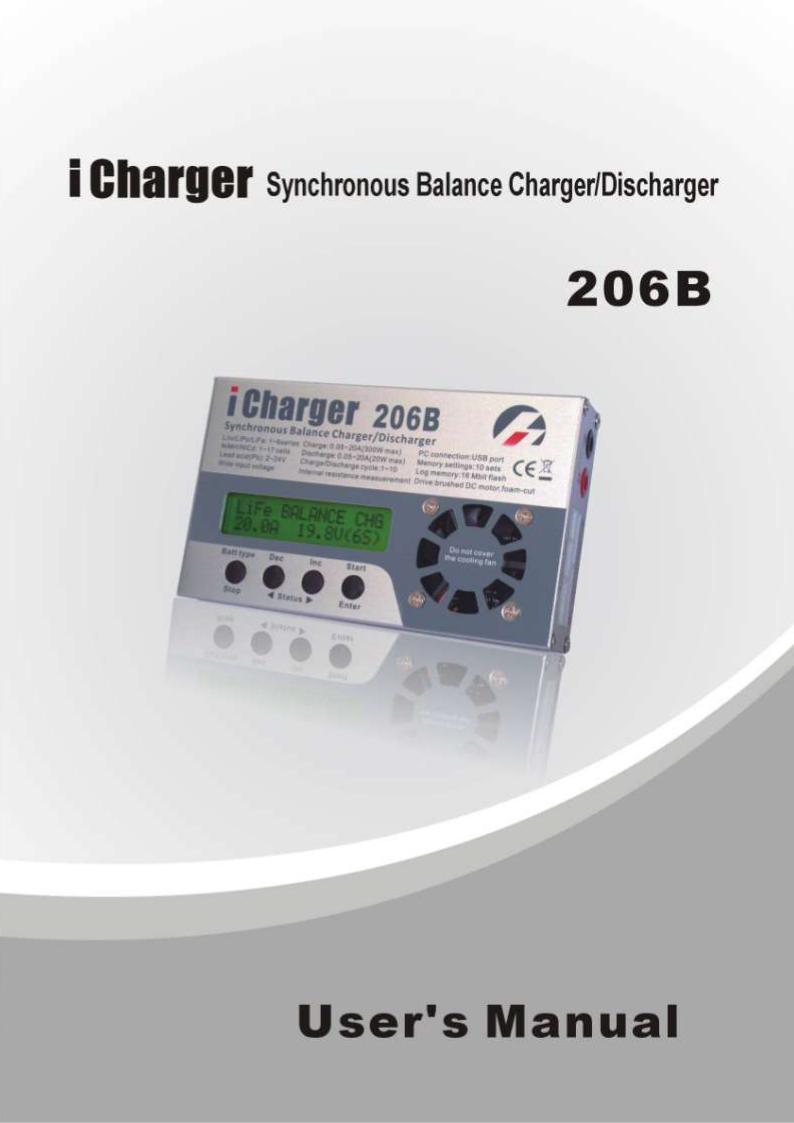

iCharger Synchronous Balance Charger/Discharger |
206B |
Index
Specifications 3 Special Features 3 Unpack Inspection 5 External Controls and Connections 5 Warnings and Safety Notes 6 Program Flow Chart 7 Keyboard Basics 8 Parameter Setup 9 Lithium Battery Program 13
Charging Lithium Battery in BALANCE Mode 14 Charging a Lithium Battery in Normal CHARGE Mode 15 Fast Charging a Lithium Battery 15 Pre-charging a Lithium Battery 16
“Storage” charge/discharge a Lithium Battery 16 Discharging a Lithium Battery 17 Lithium Battery External Expanding Discharge Mode 18 Cycle Mode for a Lithium Battery 19 Lithium Battery in Monitoring Mode 19
NiCd/NiMH Battery Program 20 Charging a NiCd/NiHM Battery 20 Discharging a NiCd/NiMH Battery 20 Cycle Mode for a NiCd/NiMH Battery 20 NiCd/NiMH Forming Charge 21
Pb (lead-acid) Battery Program 22 Charging a Pb Battery 22 Discharging a Pb Battery 22 Special Modes Program 23 Electric Motor Drive 23 Foam-Cut Drive 23 Measuring Internal Resistance of the Battery 24 Data Save/Load Program 25 Log Files Management 26 General Status Information 27 Warning and Error Information 27 USB port installation 29 Install USB Driver 29 Charger firmware upgrade steps 29 Using LogView for 206B 30 Optional Parts 32 Limited Warranty 33
-2-
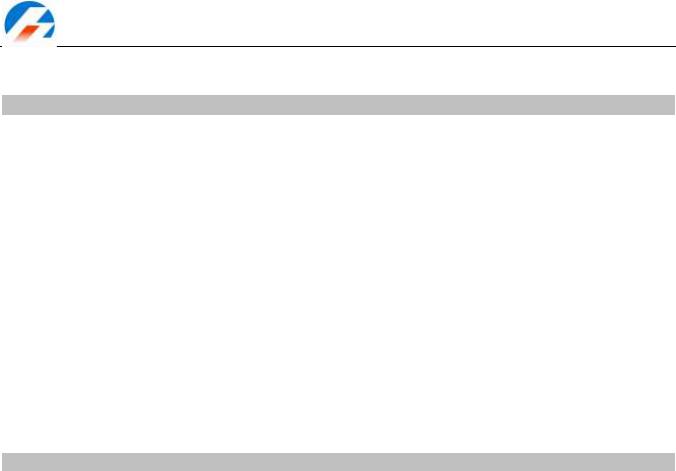
iCharger Synchronous Balance Charger/Discharger |
206B |
Thank you for purchasing one of the iCharger series. Please read the entire User‘s Manual completely and attentively as it contains a wide variety of specific programming and safety information.
Specifications
Input voltage range: |
10– 28.0VDC |
Charge current range: |
0.05 – 20.0A |
Discharge current range: |
0.05 – 20.0A |
Maximum charge power capacity: |
300W @ input voltage > 18V |
Maximum discharge power capacity: |
20W |
Maximum regenerative discharge power capacity: 300W |
|
Maximum extern discharge power capacity: |
500W @ 25V/20A |
Current drain for balancing: |
<350mA |
Balance accuracy: |
<10mV |
Lithium (LiPo/LiIo/LiFe) battery cell count: |
1 – 6 series (In non-balance mode, expand LiFe to 8s) |
NiCd/NiMH battery cell count: |
1 – 17 series |
Pb battery cell count: |
1 – 12 series (2 –24V) |
Log Files storage: |
16Mbit (36 hours) |
Battery setup memories: |
10 |
Intelligent temperature control: |
Yes |
PC Connect: |
USB port |
Weight: |
350g |
Dimensions (L X W X D): |
134X83X25mm |
|
5.28‖X3.27‖X0.98‖ |
Special features
High power, high current, high-performance power conversion circuit. The iCharger series uses advanced Synchronous buck-boost DC/DC converter technology with an output conversion efficiency that can reach over 90%. This not only saves power and reduces heat build up but also makes the charger more compact and conveniently mobile.
Input power with 4mm bullet connectors (25A) butt-welded alligator clips and wide input voltage ranges from 10V to 28V. The output power can be adjusted to align with the available input power, thus preventting input current overload and protecting the DC source.
The iCharger series can be used with three types of Lithium batteries - LiPo, Lilo, LiFe - and has a fully integrated cell balancer.
Internal temperature sensor and temperature controlled automatic cooling FAN controls the internal temperature and provides intelligent protection. When the internal temperature is over 60 (140 oF), the output power is automatically reduced by 25%. If the temperature exceeds 65 (149 oF) the charge cycle is stopped.
Convenient set of 10 battery profile memories that can be saved and loaded by number.
2x16 backlit LCD screen that provides rich information including active mode, current, voltage, total charge (mAh), charging time and temperature etc.
Various charging/discharging settings and cycles to meet a wide range of customer needs. For Lithium batteries: balance charging, normal charging, fast charging, storage, discharging, ext-discharging, charge/discharge cycling, and battery monitoring. For NiCd/NiMH batteries: charging-auto, charging-manual, discharging, charge/discharge cycling and forming charge. For Pb batteries: charging and discharging.
Up to 300w unique regenerative discharge capability. Regenerative discharge takes most of the output battery‘s energy and puts it back into the input battery, which is not the same with the traditional methods of discharge to deplete that energy in the form of heat across a transistor. That is, when you discharge your LiPo for storage, you will be re-charging your Lead Acid input battery. The amount of current and voltage that your input battery can accept limit the total amount of power that you can achieve, or 300W, whichever is lower.
Unique Lithium battery expanding discharge program. When you connect the external capacity resistance, you can use it as the maximum discharge power capacity—600W (@30V/20A).
-3-

iCharger Synchronous Balance Charger/Discharger |
206B |
Unique Lithium battery Monitor program. When you use other equipment to charge or discharge a Lithium pack, you can use the iCharger to monitor the per-cell voltages, battery temperature and process time. If any individual cell appears over-charged or over-discharged or the pack is too hot or the process has gone on for too long, the iCharger will generate an alarm sound and the related information will blink.
Electric motor test mode can be used to run-in electric motors, test motor parameters and performance, check tolerances etc.
Foam-cut drive. In this mode, the charger acts as a convenient power supply for a hot wire foam cutter.
Battery interior resistance measurement. The iCharger can not only measure the internal resistance of the battery pack, and also can measure the per-cell internal resistance (only available for lithium battery).
Perfect protection. The iCharger has protection for reversed polarity (input or output), low input voltage, battery temperature, charging capacity and time overrun.
iCharger 206B has a 16Mbit flash storage, which can log offline charge and discharge data in 36 hours.
Support upgrading the hardware program by USB port. The iCharger also support the ―logview‖ software and can display, plot and analyze the charge and discharge data by it. (See detail information about logview in the following website: http://www.logview.info)
-4-
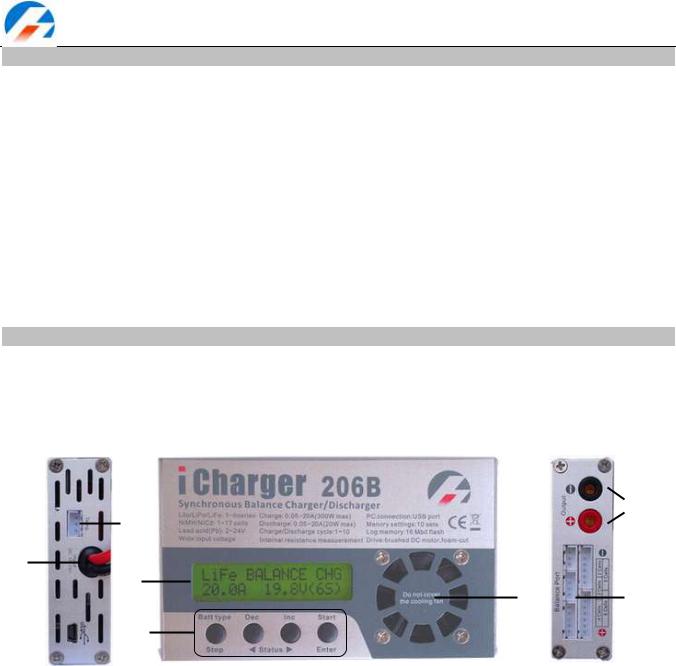
iCharger Synchronous Balance Charger/Discharger |
206B |
Unpack inspection
The following items are included in the package. Contact your supplier if any items are missing.
Standard items
One copy of the User‘s manual on CD
One pair of output alligator clip leads
One pair of input alligator clips (30A) and input leads with 4mm bullet connectors
One temperature sensor lead (0 – 99 (210 oF))
Four rubber feet
One exclusive Mini-USB data line(1.2 meter)
Optional items:
See details in ―Optional parts‖ (P32)
External controls and connections
206B
|
|
|
|
1. |
DC input 2. LCD screen 3. Function button 4. Cooling Fan 5. Temperature sensor port |
6. |
Balance socket 7. Output port 8. USB port |
-5-

iCharger Synchronous Balance Charger/Discharger |
206B |
Warnings and Safety notes
Keep the charger away from children and pets at all times.
Never leave the charger unsupervised when charging or discharging. If you leave, disconnect the battery to prevent any unexpected dangers or damage.
Ensure the charger program and settings match the battery pack otherwise the battery will be damaged and a dangerous situation may arise, especially for Lithium batteries, which may cause a fire.
Do not mix batteries of different types, different capacities or from different manufacturers.
Do not disassemble the charger.
Do not place the charger or any battery on a flammable surface or near a combustible material while in use. Do not charge or discharge on a carpet, cluttered workbench, paper, plastic, vinyl, leather or wood, inside an R/C model or inside a full-sized automobile.
Never block the air intake holes and never use in a refrigerated or high temperature environment. If used in such an environment, the internal temperature protection may result in abnormal charging/discharging that could be dangerous.
Do not allow water, moisture, metal wires or other conductive material into the charger.
Never charge or discharge any battery having evidence of leaking, expansion/swelling, damaged outer cover or case, color-change or distortion.
Do not try to charge ―non-rechargeable‖ dry cells.
Do not exceed the battery manufacturer‘s suggested maximum charge rates.
Beware that the external case temperature of the charger will increase during charging/discharging at high power.
Carefully follow the battery pack manufacturer‘s recommendations and safety advice.
Recommended connecting way:
1.Connect iCharger's input power supply, and turn on it.
2.Connect Li batteries' balance port
3.Connect the main charging port's positive pole to cells' positive pole, and then connect negative pole to cells' negative pole (this will avoid striking fire while connecting Li cells).
4.Start charging and discharging...
5.After finishing charging and discharging, pls disconnect the cell and charger, and then turn off the charger's power supply.
Standard battery parameters
|
|
LiPo |
LiIo |
LiFe |
|
NiCd |
|
NiMH |
Pb |
Nominal voltage |
|
3.7 V/cell |
3.6 V/cell |
3.3 |
V/cell |
1.20 |
V/cell |
1.20 V/cell |
2.0 V/cell |
|
|
|
|
|
|
|
|
|
|
Max. charge voltage |
|
4.2 V/cell |
4.1 V/cell |
3.6 |
V/cell |
1.60 |
V/cell |
1.60 V/cell |
2.45 V/cell |
|
|
|
|
|
|
|
|
|
|
Storage voltage |
|
3.85 V/cell |
3.75 V/cell |
3.3 |
V/cell |
n/a |
n/a |
n/a |
|
|
|
|
|
|
|
|
|
||
Allowable fast charge |
|
≤ 1C |
≤ 1C |
≤ 4C |
1C – 2C |
1C – 2C |
≤ 0.4C |
||
|
|
|
|
|
|
|
|
|
|
Min. discharge voltage |
|
≥ 3.0 V/cell |
≥ 2.5 V/cell |
≥ 2.0 V/cell |
≥ 0.85V/cell |
≥ 1.0 V/cell |
≥ 1.75V/cell |
||
cut-off level |
|
|
|
|
|
|
|
|
|
|
|
|
|
|
|
|
|
|
|
Note: Be very careful to choose the correct voltage for different types of battery otherwise you may cause damage to the batteries. Incorrect settings could cause the cells to vent, burn or explode leading to injury or loss of property.
-6-

|
|
iCharger Synchronous Balance Charger/Discharger |
|
|
|
|
206B |
|||||||
|
|
|
|
|
|
|
|
|
|
|
|
|
||
|
Program flow chart |
|
|
|
|
|
|
|
|
|
|
|
||
|
PROGRAM SELECT |
Start |
LiXX BALANCE CHG |
Inc LiXX CHARGE |
|
Inc LiXX FAST CHARGE |
Inc LiXX STORAGE |
|||||||
|
Lithium battery |
Enter |
X.XA |
AUTO |
Dec X.XA XX.XV(XS) |
|
X.XA |
XX.XV(XS) |
|
X.XA |
XX.XV(XS) |
|||
|
|
Dec |
Dec |
|||||||||||
|
|
|
|
|
|
|
|
|
|
|
|
Inc |
Dec |
|
|
|
|
|
LiXX MONITOR |
Inc LiXX CYCLE |
X |
Inc LiXX DCHG+ X.XXV |
Inc LiXX DCHG |
X.XXV |
|||||
|
|
Batt type |
X.XXV |
XX.XV(XS) |
Dec X:X.XXV->X:X.XXV |
Dec |
X.XA |
AUTO |
Dec |
X.XA |
XX.XV(XS) |
|||
|
|
|
|
|
|
|
|
|
|
|
|
|
||
|
Dec |
Inc |
|
|
|
|
|
|
|
|
|
|
|
|
|
|
|
|
|
|
|
|
|
|
|
|
NiMH FORMING CHG |
||
|
|
|
|
|
|
|
|
|
|
|
|
X.XA |
XX.XV(XS) |
|
PROGRAM SELECT |
Start |
NiMH CHARGE Aut |
|||
Enter |
|||||
NiMH battery |
|
X.XA |
CUR LIMIT |
||
|
Batt type |
|
|
||
Dec |
Inc |
Start |
|
|
|
PROGRAM SELECT |
NiCd CHARGE Aut |
||||
Enter |
|||||
NiCd battery |
|
X.XA |
CUR LIMIT |
||
|
Batt type |
|
|
||
Dec |
Inc |
Start |
|
|
|
PROGRAM SELECT |
Pb CHARGE |
||||
Dec |
Inc |
Enter |
X.XA |
XX.XV(XS) |
|
Pb battery |
|
||||
|
Batt type |
|
|
||
Dec |
Inc |
Start |
|
|
|
PROGRAM SELECT |
Lithium battery |
||||
Enter |
|||||
Settings |
-> |
|
Check Time XXmin |
||
|
|
|
|
|
|
|
Inc |
Dec |
|
Inc NiMH CHARGE Man |
Inc NiMH DISCHARGE |
Inc NiMH CYCLE |
X |
||||||
Dec |
X.XA |
CURRENT |
Dec |
X.XA |
XX.XV |
Dec |
XXX(XXX)->XXXX |
|
|
Inc |
NiCd CHARGE Man |
Inc NiCd DISCHARGE |
Inc |
NiCd CYCLE |
X |
||||
Dec |
X.XA |
CURRENT |
Dec |
X.XA |
XX.XV |
Dec |
XXX(XXX)->XXXX |
|
|
|
|
|
|
|
|
|
Inc |
Dec |
|
Inc Pb DISCHARGE |
|
|
|
|
NiCd FORMING CHG |
||||
Dec |
X.XA |
XX.XV(XS) |
|
|
|
|
X.XA XX.XV(XS) |
||
Inc |
Bal.Speed XXXXXX |
Inc Li Balance ON |
Inc Wait Time |
|
|
||||
Dec |
Bal.Trickle XXX |
Dec |
|
XXX |
Dec |
CHG/DCHG |
XXmin |
||
|
|
|
|
|
|
|
Inc |
Dec |
|
|
NiMH/NiCd Check |
Inc |
NiCd Sensitivity |
Inc |
NiMH Sensitivity |
Inc |
NiMH/NiCd/Pb |
||||
|
Delay |
XXmin |
Dec |
DeltaV XXmV/Cell |
Dec |
DeltaV XXmV/Cell |
Dec |
Trickle |
XXXmA |
||
|
Inc |
Dec |
|
|
|
|
|
|
|
|
|
|
Temp. Cut-Off |
Inc Safety timer |
Inc Capacity Cut-Off |
Inc Input limit XX.X |
|||||||
|
XXX |
XX Dec |
XXX |
XXXmin |
Dec |
XXX |
XXXXXmAh |
Dec |
Cut-Off |
XX.XXV |
|
|
Batt type |
|
|
|
|
|
|
|
|
Inc |
Dec |
Dec |
Inc |
|
|
|
|
|
|
|
|
||
|
Inc Completion Ring |
Inc Key Beep |
|
Inc Watt Limit (W) |
|||||||
|
Back-light XX% |
XXX |
|||||||||
|
Cooling fan XXXX |
Dec |
|
Beep XXX |
Dec |
Buzzer |
XXX |
Dec |
CHG:XXXX DCHG:XX |
||
|
Inc |
Dec |
|
|
|
|
|
|
|
|
|
|
Discharge reduce |
Inc Regenerative DSC |
Inc LiFe Termination |
Inc Lilo Termination |
|||||||
|
OFF |
XX% |
Dec |
XXX XX.XA XX.XXV |
Dec |
Voltage |
X.XXV |
Dec |
Voltage |
X.XXV |
|
PROGRAM SELECT |
Start |
MOTOR DRV |
XXmin |
Inc FOAM |
CUT XXmin |
Inc |
|
Special |
modes |
Enter |
X.XA |
XX.XV |
Dec X.XA |
XX.XV |
|
|
Dec |
||||||
|
Batt type |
|
|
|
|
|
|
Dec |
Inc |
Start |
|
|
|
|
|
PROGRAM SELECT |
SAVE SETTINGS XX |
|
|
|
|||
Enter |
|
|
|
||||
Save settings |
|
memoryX |
|
|
|
|
|
|
Batt type |
|
|
|
|
|
|
Dec |
Inc |
Start |
|
|
|
|
|
PROGRAM SELECT |
LOAD SETTINGS XX |
|
|
|
|||
Enter |
|
|
|
||||
Load settings |
|
memoryX |
|
|
|
|
|
Measure Internal resistance
Inc Dec
LiPo Termination
Voltage X.XXV
Inc Dec
Pb Termination
Voltage X.XXV
Note: When you turn off the iCharger it will remember the current menu and start from that menu when next turned on again.
-7-
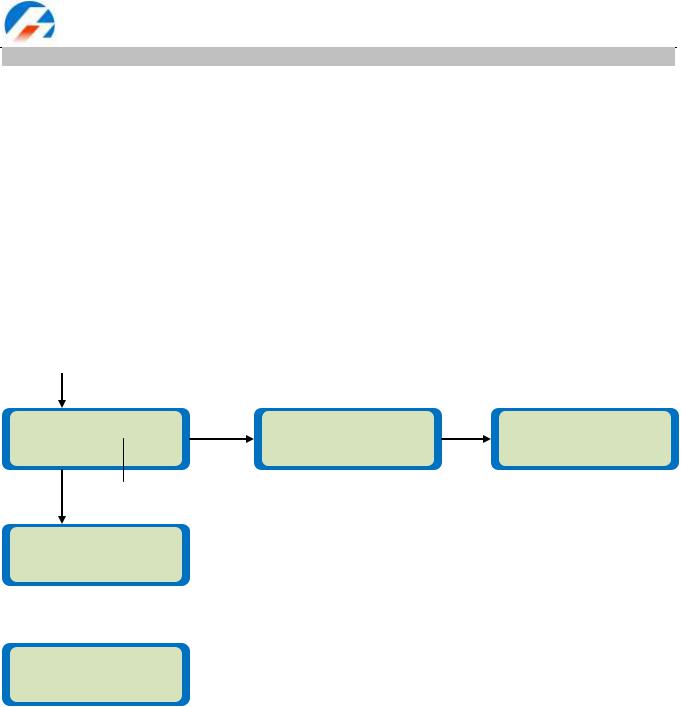
iCharger Synchronous Balance Charger/Discharger |
206B |
Keyboard basics
1.Go to the main menu, press the Inc button or the Stop/Batt type button to go down, and press the Dec button to go up: press the Start/Enter button to enter a sub-menu.
2.In a sub-menu, press Start/Enter to blink the chosen item, and then alter the value with Inc or Dec. With nothing blinking you can go to the sub-menu below with Inc and above with Dec. Press Stop/Batt type to go back to the previous screen.
3.In some sub-menus, press and hold Start/Enter for more than 3 seconds to start the process, such as starting charging or discharging.
4.During the charging/discharging process you can terminate the process at any time by pressing Stop/Batt type and check the attached information with IncorDec. Press Start/Enter to go back to the main information screen.
5.During the discharge process, press Start/Enter to alter the discharge current. When the discharge current blinks, press Inc to increase it or Dec to decrease it, then press Start/Enter to confirm the change.
6.Press Stop/Batt type for more than 3 seconds to start the display of the active test information as per the following diagram.
Present testing information
In this display the output voltage is the idle voltage measured at the output terminals (that is, the voltage of the connected battery pack).
Stop/Batt type >3 seconds
Vi11.94V Int30 Dec |
1: 21 24 |
mΩ |
Dec Battery Pack IR |
||||||||||||
|
|
|
|
|
|
|
|
|
|
|
|
|
|
|
|
Vo 8.23V |
Ext25 |
|
4: |
mΩ |
45mΩ |
||||||||||
|
|
|
|
|
|
|
|
|
|
|
|
|
Per cell resistance from |
|
|
Output |
|
Input |
Int. |
Ext. |
|
Pack cells resistance from |
|||||||||
Volt. |
|
Volt. |
Temp. |
Temp. |
|
|
|
||||||||
|
|
the balance port. |
|
|
|||||||||||
|
|
|
|
|
|
|
|
|
|
||||||
|
|
|
Inc |
|
|
|
|
|
the balance port. |
||||||
1:4.11 4.12 ---- |
Individual cell voltage from |
|
|
||||||||||||
4:---- ---- ---- |
the balance port. |
|
|
||||||||||||
|
|
|
|
||||||||||||
7.Reset to Defaults function. Press Stop/Batt type and Start/Enter together for more than 3 seconds to obtain this display:
Resume defaults? CONFIRM (ENTER)
Press Start/Enter to reset all values to the system-default settings.
8.Adjust Current, Temp. Cut-Off, Safety timer, Capacity Cut-Off in course of charging and discharging.
Method of Application:
When in charging and discharging interface, press Start/Enter for 3 seconds, and current begins blinking.
Press IncorDec to adjust current, and press Start/Enter to save changes. If users press Stop/Batt type or without any operation for 1 minute, it will cancel and quit from the changes.
Note: Adjustment of current is only effective for charging and discharging, which will not saved as user setting.
When in charging and discharging interface, press Dec for several times to see need-to-be changed information interface. Press Start/Enter for 3 seconds, and the value begins blinking. The adjust method is as same as the above.
Note: This change can be saved as user setting.
-8-
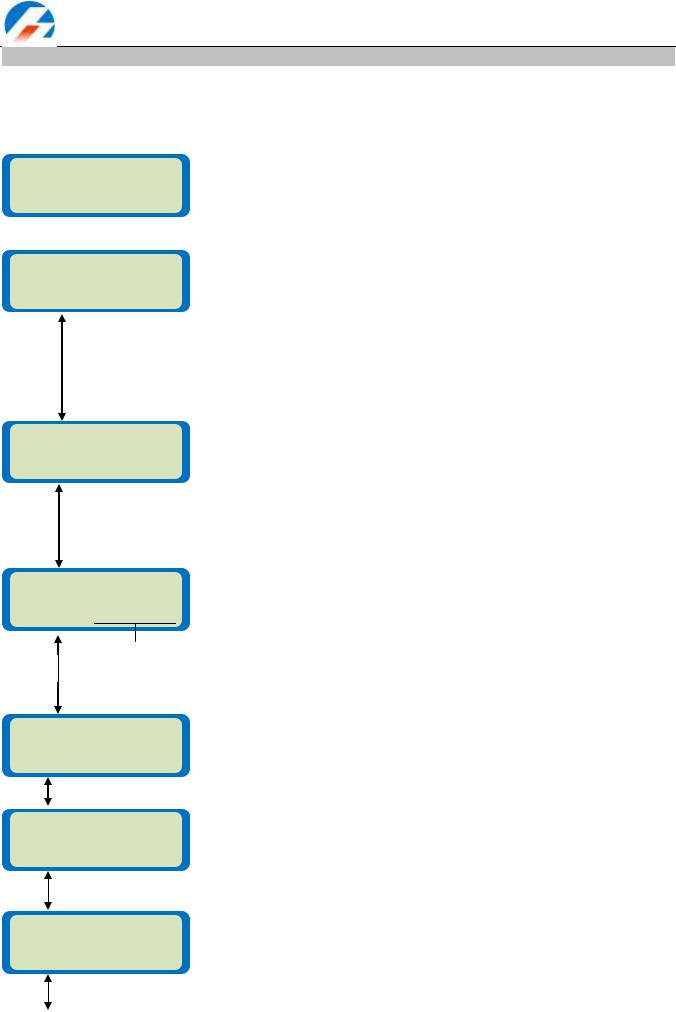
iCharger Synchronous Balance Charger/Discharger |
206B |
Parameter setup
Users should check the parameter settings and adjust the parameter values according to the specifications of the pack to be charged or discharged.
Note: The screen diagram on the left shows the system‘s default setting.
PROGRAM SELECT Settings ->
 Start/Enter
Start/Enter
Lithium battery
Check Time |
1min |
|||
|
- |
|
|
+ |
|
|
|
||
Dec |
Inc |
|||
Dec Inc |
|
|
|
|
Bal.Speed Normal |
||||
Bal.Trickle |
|
OFF |
||
|
||||
|
- |
|
+ |
|
|
|
|||
|
Dec |
Inc |
||
Dec Inc
Li Balance ON
CV phase
- +
Dec Inc
Dec Inc
Wait Time CHG/DCHG 10min
Dec |
Inc |
- |
|
+ |
|
||||
Dec |
|
Inc |
NiMH/NiCd/Pb |
|
|
|
||
Trickle |
|
OFF |
|||
|
|
- |
|
|
+ |
|
|
||||
|
|
|
|||
|
|
Dec |
|
|
Inc |
Dec |
Inc |
|
|
|
|
NiMH Sensitivity |
|||||
DeltaV |
Default |
||||
|
|
- |
|
|
+ |
|
|
||||
|
|
|
|||
|
|
Dec |
|
|
Inc |
Dec |
Inc |
|
|
|
|
User parameter setup initial display.
iCharger checks the cell count of Lithium batteries automatically at the beginning of the charge or discharge process in order to detect and avoid erroneous setting by the user. However, deeply discharged batteries can be perceived incorrectly. To avoid this problem you can set an initial time during which to charge the battery at a low current, usually 100mA. Normally 10 minutes is enough to detect the cell count correctly. For batteries of different capacities, you should adjust the time delay. Note: If you set the time delay too long for a low capacity battery then the charging process can be finished within the time delay with an erroneous cell count, which may damage the battery and could be dangerous.
Range: 1 – 10 min. (1min, default)
For balance charging Lithium batteries. If the Bal. Speed is set to Fast, the CV termination current will be higher, the charging time shorter and the per-cell voltage lower. When set to Slow, the CV termination current will be lower, the charging time longer and the per-cell voltage higher. The default value of Normal is between the Fast and the Slow. If Bal. Trickle is ON, the iCharger won‘t stop charging until the current falls to around 20mA.
Bal.Speed: Fast, Normal & Slow, (Normal, default). Bal.Trickle: OFF & ON: (OFF, default)
For balance charging Li battery. There are three balance modes options: CV phase, storage voltage and always. If the balance mode is set to CV phase, when any cell‘s voltage reaches the set voltage for CV, it will enable the balancer. When set to ―always‖, the balancer will be enabled from the beginning of the charge process. When set to ―storage voltage‖, the balancer will be enabled when any cell‘s voltage exceeds the default storage voltage for the configured chemistry.
Balance mode: CV phase, storage voltage, always (CV phase, default)
When running a charge/discharge cycle program for a Lithium, NiMH or NiCd battery the charger will stop for a while before continuing to the next phase. This allows the pack to cool down.
Range: 1 – 60 min. (10 min default)
You can turn post charge-completion trickle charging. On or Off for NiMH, NiCd or Pb batteries.
Range: OFF, 10 – 500mA. (OFF,default)
Usually, the NiMH battery voltage will drop a little right after reaching full charge. This is known as - V. You can alter the iCharger‘s delta-peak detection sensitivity.
Range: 1 – 20mV/Cell. (4mV/Cell, default)
-9-

iCharger Synchronous Balance Charger/Discharger |
206B |
NiCd Sensitivity
DeltaV Default
- +
Dec Inc Dec Inc
NiMH/NiCd Check
Delay |
|
0min |
|||||
|
|
|
|
|
- |
|
+ |
|
|
|
|
|
|||
|
|
|
|
|
|
||
|
|
|
Inc |
|
Dec |
Inc |
|
Dec |
|
|
|
|
|||
Temp. Cut-Off |
|||||||
ON |
|
50 |
|||||
- |
|
+ |
|
- |
+ |
||
|
|
||||||
Dec |
|
Inc |
|
Dec Inc |
|||
|
|
|
Dec |
Inc |
|
||
Safety timer |
|
||||||
ON |
|
120min |
|||||
- |
+ |
|
- |
|
+ |
||
Dec |
|
Inc |
|
Dec |
Inc |
||
|
|
Dec |
Inc |
|
|||
Capacity Cut-Off
ON 5000mAh
Usually, the NiCd battery voltage will drop a little right after reaching full charge. This is known as - V. You can alter the iCharger‘s delta-peak detection sensitivity.
Range: 1 – 20mV/Cell. (8mV/Cell, default)
When NiMH&NiCd batteries are deeply discharged or left unused for a long time, they will produce a false - V which stops charging early. You can disable - V testing to avoid this problem.
Range: 0 – 30min (0, default)
Battery upper temperature limit. The battery temperature can be monitored with the attached temperature sensor. In order to protect the battery from damage due to high temperatures the iCharger will stop charging or discharging immediately if the temperature exceeds the cut-off setting. Users can choose or oF as the temperature unit
Range: 20 – 80 (68 – 176 oF). oF = (9/5)× +32.
Charging time upper limit. The charging process will stop immediately if it exceeds the set value.
Range: 1 – 999min
Capacity protection. The charging/discharging process will stop immediately if the calculated charge input/drained exceeds the set value.
Range: 100 – 99900mAh
- |
|
+ |
- |
|
+ |
|
|
||||
Dec |
|
Inc |
Dec |
|
Inc |
|
|
Dec |
Inc |
|
|
Input limit 22.0 Cut-Off 10.00V
- +
Dec Inc Dec Inc
Watt Limit (W)
CHG:AUTO DCHG:15
- |
|
+ |
- |
+ |
|
||||
Dec |
|
Inc |
Dec |
Inc |
Dec |
Inc |
|
||
Input voltage protection lower limit. The charging/discharging process will stop immediately if the input voltage falls below the set value.
Range:10.00 – 25.00V (10.00V, default) Current Range: 1.0A – 22.0A(22.0A, default)
Note: Current limit is not very accurate, which may be 20% difference, max.
Charge/Discharge power limit. The maximum charge/discharge power of iCharger can be adjusted in order to limit internal temperature and to protect the input current from over-loading. When the limit is set to AUTO the iCharger can adjust the output charging power according to the input capability.
CHG: 50 –300W and AUTO. DCHG: 5 –20W
Note: The maximum charge power capacity is also limited by input current. The maximum input current of 206B is about 21A, and Wmax ≈ Imax * Vin * 90%. (For example, when the input voltage is 11V, the maximum charge power capacity ≈21×11×90 207W).
iCharger206B: MAX. OUTPUT POWER vs. INPUT VOLTAGE
|
320 |
|
|
|
|
|
|
|
power(W) |
300 |
|
|
|
|
|
|
|
280 |
|
|
|
|
|
|
|
|
260 |
|
|
|
|
|
|
|
|
|
|
|
|
|
|
|
|
|
Output |
240 |
|
|
|
|
|
|
|
220 |
|
|
|
|
|
|
|
|
200 |
|
|
|
|
|
|
|
|
Max. |
|
|
|
|
|
|
|
|
180 |
|
|
|
|
|
|
|
|
|
|
|
|
|
|
|
|
|
|
160 |
|
|
|
|
|
|
|
|
10 |
11 |
12 |
13 |
14 |
15 |
16 |
17 |
|
|
-10- |
|
Input voltage(V) |
|
|
|
|
|
|
|
|
|
|
|
|
|
